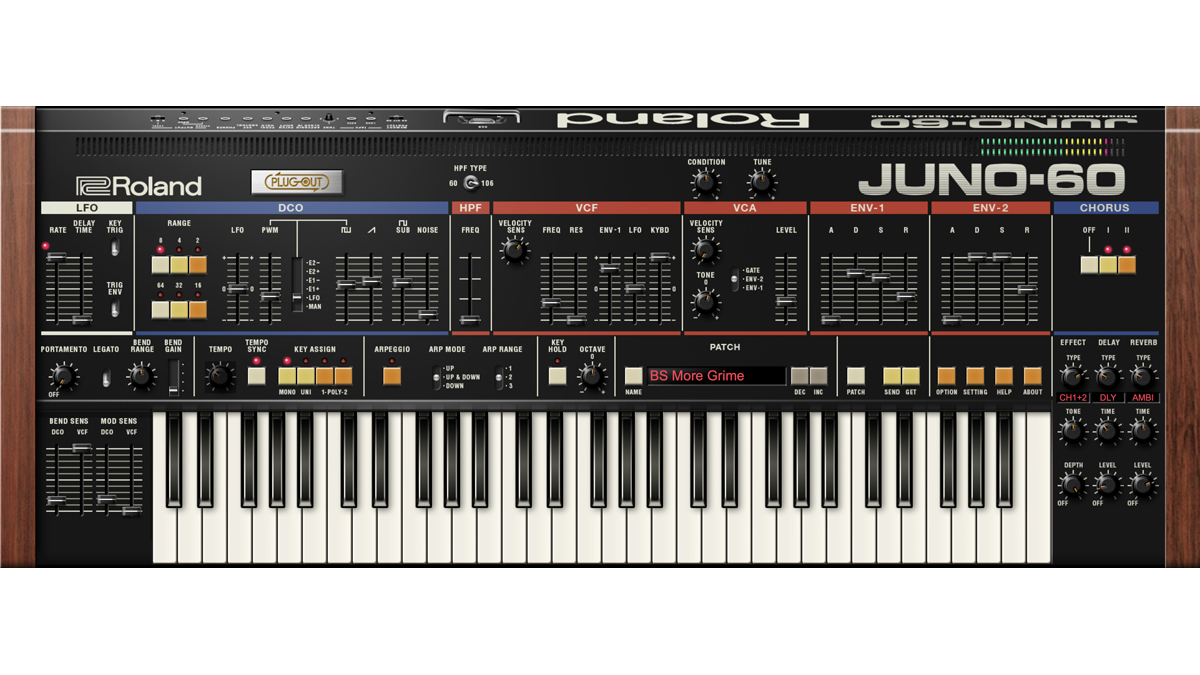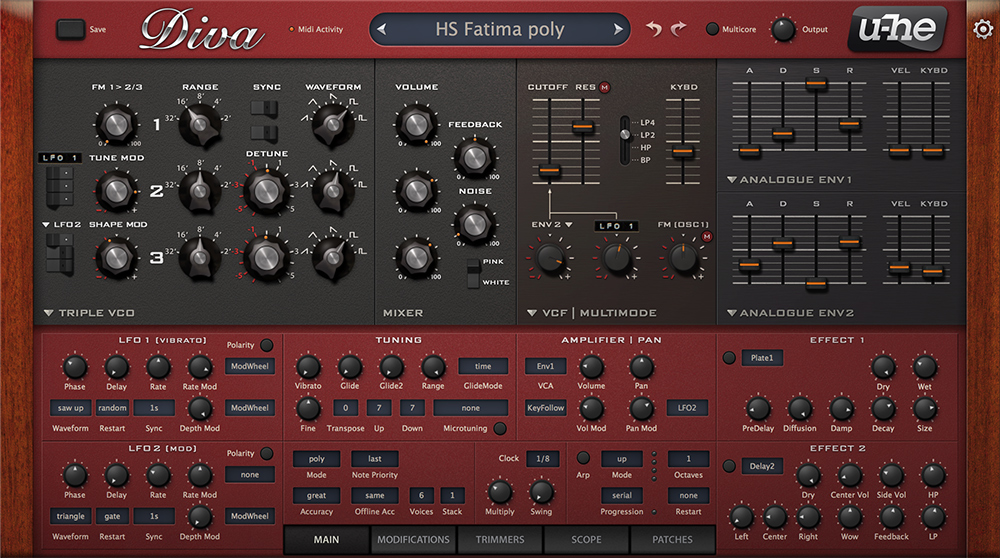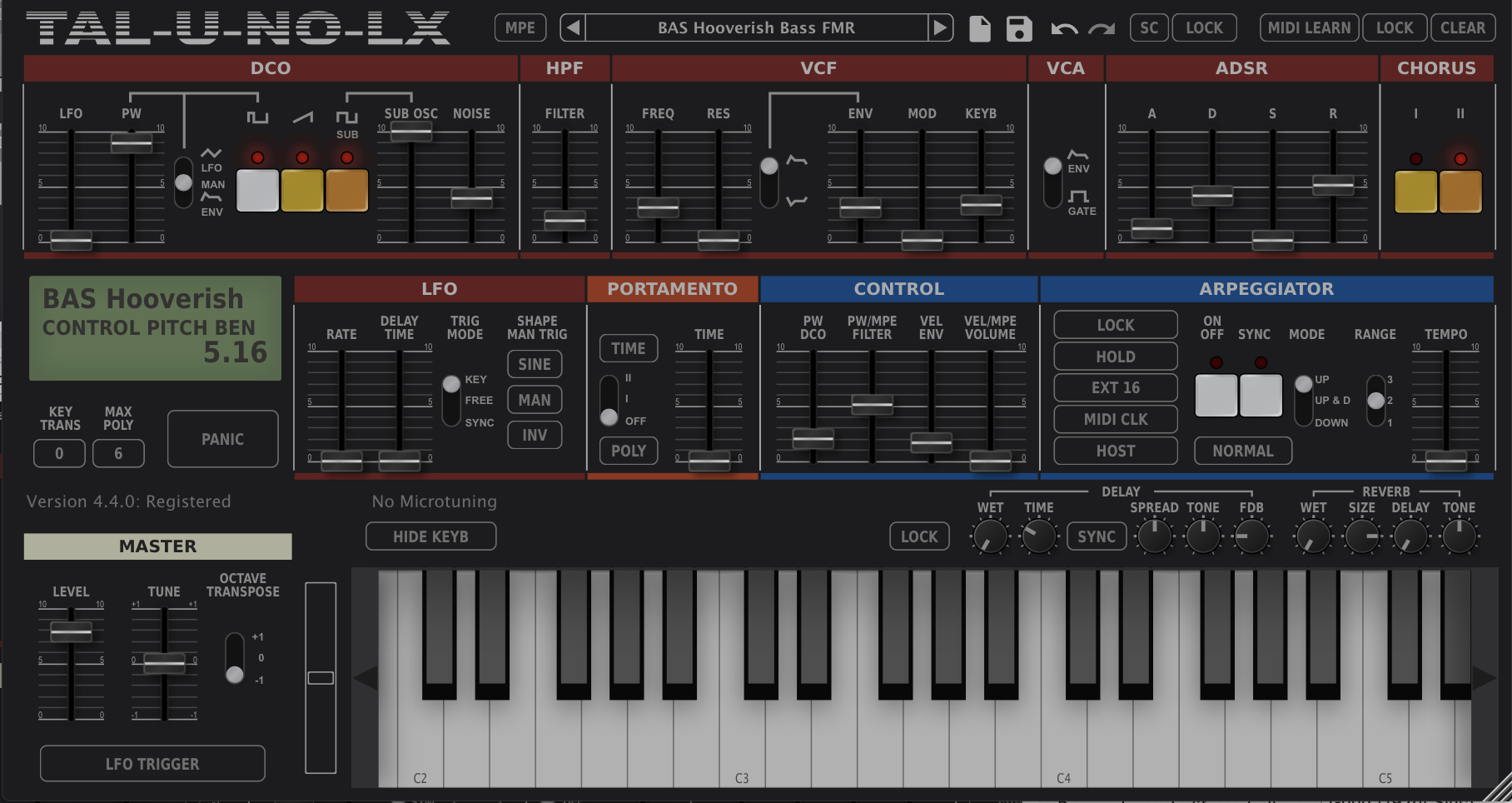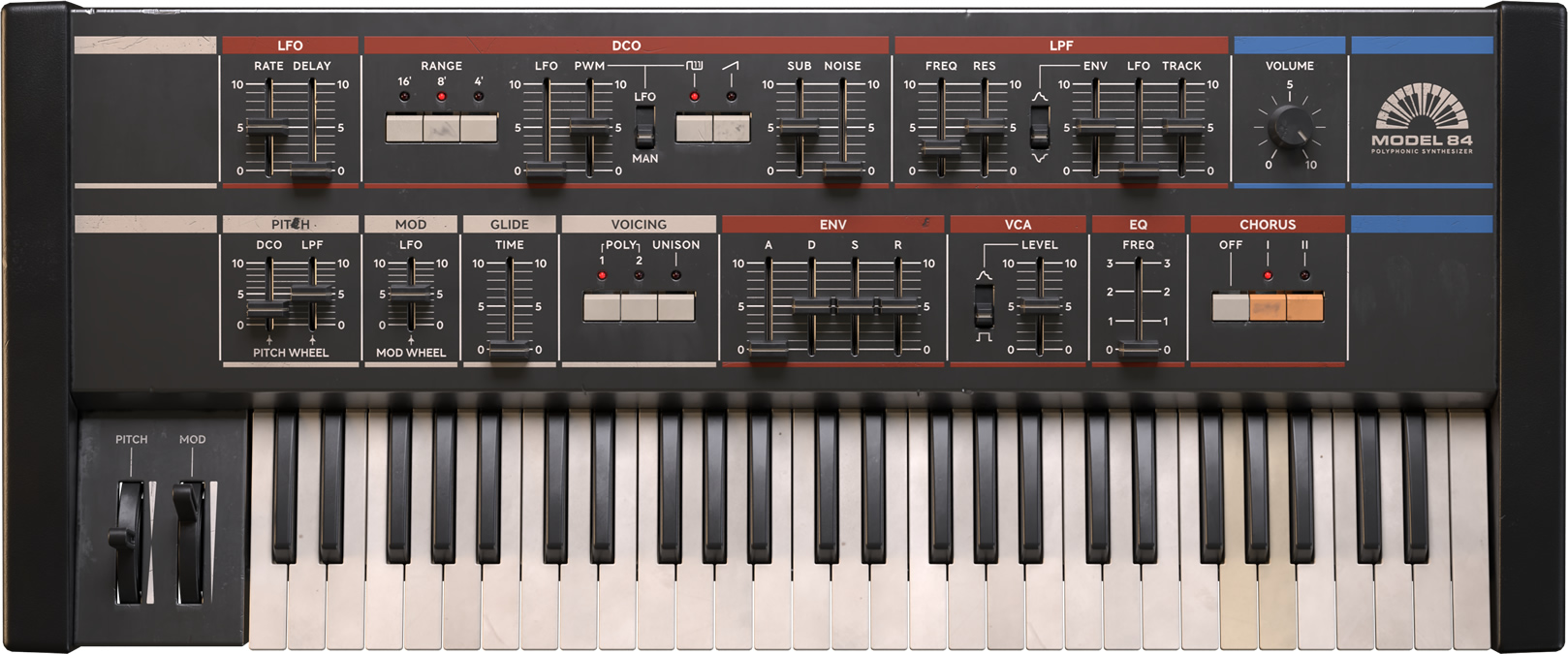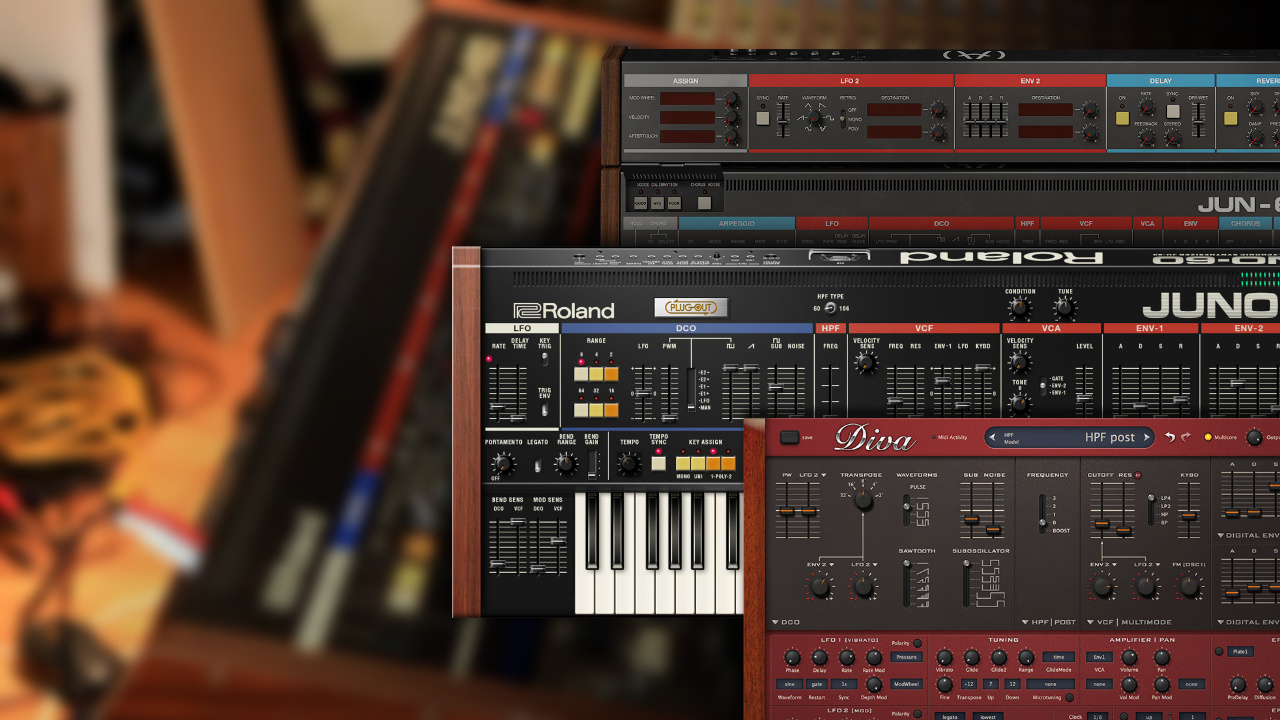
The best Roland Juno 106 & Juno 60 emulations
The Roland Juno 60 and Roland Juno 106 were two of Roland's most iconic synthesizers from the 1980s. They had an unmistakable signature sound. In this article, we'll take a look at some Roland Juno software emulations for your DAW that will help you to recreate the classic sounds of the 1980's or discover entirely new ones.
The Roland Juno-106 is a very common and widely used analog poly synth. It continues to be one of the most popular analog synths due to its great sound and easy programmability. While less powerful than other synths at it's time, the 106 was one of Roland's first fully MIDI equipped synthesizers. The Juno 106 could store 128 patches instead of the Juno 60's 56. The Roland Juno 60 is often said to have an edge over the more advanced 106 due to the more punchy sounding oscillators.
The Roland Juno-106 is a six-voice polyphonic and programmable analog synth with one digitally controlled oscillator (DCO) per voice. Although classic mono synths used two or three oscillators to create a fuller sound, the Juno-106 uses Roland's famed chorus effect for enhanced fatness. The nature of its DCO meant it was stable and always in perfect tune but still warm and analog. Filtering options include a 24dB/oct analog lowpass filter with plenty of resonance, capable of self-oscillation and a non-resonant high pass filter. The programmable pitch/mod bender combo can be assigned to control the pitch, filter cutoff, and LFO amount all at once or individually.
The Juno-106 is a powerful, straightforward synth with an easy to understand panel layout. It's got great sound and plenty of features for any level of electronic musician or synthesizer enthusiast and has been famously used by artists such as Chemical Brothers, Laurent Garnier, Vangelis, Sigur Ros, The Prodigy, Josh Wink, William Orbit, The Pet Shop Boys and many many more.
Digital emulations of analogue hardware have come a long way, and the Juno series has proven particularly popular as a subject for virtual instrument developers. Roland themselves released their Roland JUNO-106 emulation and Juno-60 VST plugins, but there are plenty of others available. In this article, we're going to dive into a few of the best Roland Juno emulation options for getting that classic sound in your productions.
Roland Cloud is a suite of software synthesizers and sampled instruments, connected services and software for modern music creators. The global community of artists, creators and dreamers have easy-access to an ever-growing catalog of legendary and brand-new software instruments.
Both the Roland Juno 106 and Juno 60 VST plugins are available as part of the subscription service and are highly regarded as being accurate and true to the original classic hardware poly synth.
Features
- Detailed reproduction of the legendary JUNO-60 using ACB technology
- Authentic filter sound with switchable JUNO-60/JUNO-106 high-pass filter voicing
- Luscious JUNO chorus, plus classic CE-1, reverb, flanger, tempo delay, and overdrive effects
- Available polyphony increased to eight (or keep it old school and limit it to six or less)
- Two fully adjustable envelopes
- Condition knob to adjust the age characteristics of the virtual hardware
- Original fast-and-effective arpeggiator design
- Fully resizable interface suits a wide range of resolutions and screen sizes
- VST3, AU, and AAX compatible
- PLUG-OUT compatibility with the SYSTEM-8 hardware synth
- Pre-mapped for one-to-one control from the SYSTEM-8, JU-06, and JU-06A hardware
Diva's oscillators, filters and envelopes (which can be mixed and matched) closely model components also found in some of the great monophonic and polyphonic synthesizers of yesteryear. "But, " says Urs, "what truly sets DIVA apart is the sheer authenticity of the circuit emulations – at the cost of a relatively high CPU-hit, DIVA is the first native software synth that applies methods from industrial circuit emulators (search for "PSpice") in realtime. Especially the authentic behaviour of DIVA's zero-delay-feedback filters, when pushed to the limits, demonstrates the advantages of this groundbreaking approach."
u-he describes the available filters as "famous transistor ladder", "screaming Sallen-Key", "classic OTA ladder" and "OTA state-variable" (and similar for the oscillators), and owners of classic analogue synths will already know how best to apply these models – they are easily differentiated in the gorgeous user interface.
Since Version 1.3 Diva also features a Digital Oscillator, an "Uhbie" filter and a vintage-style Arpeggiator alongside the original components from the Roland Juno 60, Jupiter 8, Korg MS-20 and Moog Minimoog.
TAL-U-NO-LX is a fully rewritten emulation of the popular hardware with a new engine and GUI. Up to date zero feedback delay filters and carefully calibrated controls make this synth a good replacement for the analog device with all the advantages software plugins have. As an addition, the TAL-U-NO-LX also supports portamento and different filter LFO waveforms and some more useful features. An arpeggiator with different sync modes and hold function is also included. A very fast envelope with a smooth roll-off and emulated inaccuracy gives this synth the typical sound. The synth was calibrated after a hardware device that's property of TAL:
- Self resonating zero feedback delay filter (24dB LP).
- Filter range up to ~40kHz (depends on the sample rate).
- Calibrated and tuned after TAL's hardware device.
- MIDI learn / automation for all controls.
- Improved alias free oscillators for an authentic sound also @ 44'100Hz sampling rate.
- Arpeggiator with different sync modes (host, MIDI clock, not on).
- Portamento and mono mode.
- LFO manual trigger button.
- Sustain pedal support.
- Up to 12 voices.
- New file based preset system for transparent preset management.
- More than 300 factory presets by different sound designers (FMR, Particular - Sound, TAL).
- Original hardware "Factory Bank A" included.
Jun-6 V's hardware predecessor was released at a time when a polyphonic synth was a luxury. Many consider the Juno series to have struck a rare and perfect balance when it comes to synthesizer design. Their ease of use, vivid analog sound, and relative affordability helped put the coveted multi-voiced within reach of a bigger audience.
The Juno synths were notoriously easy to use - Jun-6 V is no different. From the minute you open it up, you'll be in familiar synthesis territory, from the simplicity of DCOs to the instant stereo glory of BBD chorus. Dial in a dynamite sound that's true to the original in no time.
To bring you the authentic Juno experience, Arturia even went to the lengths of offering different levels of analog voice dispersion. Subtle variations in condition and voltage sometimes meant that each voice was very slightly different, from filter cutoff to VCA envelope attack. Choose a level of analog drift to suit your taste - squeaky clean, rough around the edges, or somewhere in the middle.
Jun-6 V takes the classic arpeggiator formula back to basics, so you can instantly weave driving hypnotic patterns on the fly, just like the good old days. Put aside complex multi-mode arp algorithms - simplicity and musicality is the aim of the game.
Jun-6 V perfectly emulates the simple yet refined sculpting capabilities of its '80s ancestor. Go for bubbling low-pass warmth, dynamic high-pass tension, or a combination of the two. Jun-6 V represents the virtual rebirth of a classic; it doesn't end there though. Arturia expanded this polysynth icon with just enough extra modulation & FX tricks to enhance its sound without compromising its signature simplicity.
The Juno 6 was renowned for its simplicity. Meticulously-modeled DCOs (digitally controlled oscillators) kept everything in tune, with a dynamite blend of square, ramp, sub, and noise. Your sound was shaped by a simple but effective twin filter setup. Add an LFO, an ADSR envelope, and a 3-mode stereo chorus, and you've got yourself a Juno. Arturia took this familiar formula and cranked it up a few notches.
Jun-6 V is a hands-on, express-yourself kinda synthesizer, with an irresistible sound that begs to be played over and over - it doesn't end there though. Arturia expanded this polysynth icon with just enough extra modulation & FX tricks to enhance its sound without compromising its signature tactile simplicity. With the Modwheel, tweak the LFO intensity for the DCO and/or VCF, or assign to a destination of your choice. Assign Velocity or AfterTouch to a modulation destination of your choice for dynamic movement that responds to every touch.
One envelope has become two, and a second multi-waveform LFO has been added to the mix. The second ADSR envelope features two freely assignable destinations, as does LFO 2. Perfectly accessible modulation that adds just enough movement without detracting from Jun-6 V's hands-on playability.
Transform every note into a full-sounding chord with chord mode, and choose from 12 voicings including your own custom voicing. Unison assigns multiple voices to a single note for condensed fatness, perfect for pumping bass arps or red-hot leads - choose your density and detune to taste. On the FX front, you'll find some additional spacious reverb and delay. This simple addition takes Jun-6 V's unmistakably vintage sound and sets it up for contemporary application. Cinematic ambience, stadium-sized pop chords, and bouncing trap lead lines are all within reach.
Features:
- A next generation component-level model of the Roland Juno-6.
- State of the art analog Chorus reproduction.
- 3 Voice calibration states for true analog realism.
- Free-running phase oscillator with up to 36 voices of polyphony.
- Unison & Portamento.
- Voice detune control for analog pitch behavior.
- Arpeggiator.
- Customisable Chord mode.
- Performance optimised controls (Bender, Mod and assignable keyboard parameters).
- Extra LFO and Envelope for enhanced modulation capabilities.
- Built in modulatable Delay and Reverb.
- Advanced Brightness, Timbre, Time and Movement macro controls.
- Built in tutorials.
- 180 factory presets.
Recreating the sound of a classic synthesizer is no easy task. DCO-106 lovingly recreates the unique sonic footprint of one the most iconic 80's polysynths in exhaustive detail, while adding modern features for massively expanded creativity.
The DCO-106 is both easy to understand and powerful to explore, creating a massive array of sonic landscapes, cutting lead sounds, warm and hazy pads, punchy synthetic electro drums, and far more.
DCO-106 Features:
- Every aspect precisely modeled in exacting detail.
- 330+ presets, including original 106 Factory Presets.
- Up to 16-voice polyphony.
- Rich stereo chorus.
- Three lush reverb modes, gorgeous new proprietary reverb algorithm.
- Full-featured delay section with tempo sync.
- Multiple voice assign modes.
- Single-key chord memory mode.
- Expanded LFO section with six waveforms and tempo sync.
- Unison detune for massive lead and bass sounds.
- MPE support.
- Full MIDI control.
- Full DAW automation for all controls.
- Fully compatible with original 106 SysEx commands.
- DCO-106 is available in AU, VST, VST3, AAX, and Standalone formats.
Testimonials:
We live in the age of the reissue and 'copycat' synthesizer. What the people at Cherry Audio have done is capture the soul of the Juno-106 and evolve it so it is an everyday part of my creative process. Wonderful.
Michael Whalen - Emmy Award winning film & TV composer, and international recording artist.
I played in bands when the first Juno-106 came out and always wanted one, but I never owned one until many years later. Cherry Audio has nailed the 106, plus they've added features we could've never dreamed of in the original. I'll be incorporating DCO-106 into my film scores and live shows. I love this instrument, highly recommend.
Mike McKnight - Keyboardist, programmer, and music director. Credits include Roger Waters, Mariah Carey, Madonna, Michael Jackson, Whitney Houston, Earth Wind and Fire, George Michael, Paula Abdul, Lady Gaga, U2 and many others on tour and in the studio.
A free 30-day demo of DCO-106 is available. This demo will play random tones periodically, but is otherwise unlimited.
macOS Requirements: macOS 10.11 or above, 64-bit required. Quad-core computer with 8GB of RAM recommended.
Windows Requirements: Windows 7 or above, 64-bit required. Quad-core computer with 8GB of RAM recommended.
Model 84 is a highly accurate emulation of the storied polyphonic synthesizer that became a music industry staple. Every trait, trick, and mannerism of the original hardware is now available to you in software form.
You get the unadulterated sound and behavior of the original with dead-perfect execution every time. The mod-wheel and pitch-wheel assignments affect your pitch, filter, and vibrato in the software the same as they would in the original 1980s gear. The perfectly recreated LPF tracking allows you to play the filter when self-oscillating, just like in the 1984 model unit. And the glide function gives you proper voice allocation—even when the sustain pedal is held down—encouraging wonderfully-creative playing techniques in the two poly modes. Just like the original. With the true-blue authentic Model 84 Polyphonic Synthesizer plug-in, you get the best of the quintessential '80s sound right in your DAW. No shoulder pads or feathered hair required.
Features:
- The authentic sound of the 1980s in plug-in and module form.
- Meticulously modeled on a pristine 1984 polyphonic synthesizer.
- Three versions included: Model 84 Instrument, Model 84 Chorus module for Softube Amp Room, and seven Model 84 modules for Softube Modular. Learn more about Softube Amp Room and Softube Modular.
- The unison phase sounds of the original.
- Included factory presets for easy recall of classic sounds.
- Stunning artist presets—from classic sounds to contemporary, crispy leads.
- Increased velocity and aftertouch support for added control over the amp, filter, and PW.
- The addition of extended unison mode for higher control over sync.
- An expanded control panel with added parameters for fine-tuning.
- Pitch and mod wheel assignment, glide, and voice allocation for creative playing.
Read more
The top 10 free synth plugins you should try in 2021
Artist Focus: BT talks about his top 5 essential VST plugins
Read More Best of

Discussion
Please log in to join the discussion

